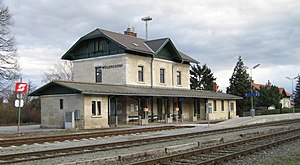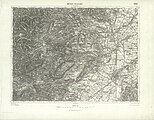
The Austrian Federal Railways, now commonly known as ÖBB, is the national railway company of Austria, and the administrator of Liechtenstein's railways. The ÖBB group is owned entirely by the Republic of Austria, and is divided into several separate businesses that manage the infrastructure and operate passenger and freight services.

Puchberg am Schneeberg is a town in the south-eastern part of Lower Austria with approximately 2650 inhabitants. It is situated about 80 Kilometres from Vienna. The highest point of Puchberg is the Schneeberg with 2076 m, the highest mountain of Lower Austria.

The Schneeberg Railway is one of three rack railways in Austria still operating, and runs from the small town of Puchberg am Schneeberg in Lower Austria up to a plateau beneath the Schneeberg summit. At 2,076 metres (6,811 ft), the Schneeberg is the highest mountain in Lower Austria. The other two working cog railways in Austria are the Schafberg Railway and the Achensee Railway.

The Mariazell Railway is an electrically operated 760 mm narrow-gauge railway which connects the Lower Austrian capital of Sankt Pölten with the Styrian pilgrimage centre of Mariazell. The line was opened in stages between 1898 and 1907, and had a, now closed, branch to Wieselburg an der Erlauf. The railway is operated by NÖVOG, which is owned by the provincial government, and is a part of the Verkehrsverbund Niederösterreich-Burgenland.

Rail transport in Austria is mainly provided by Austria's national rail transport company, the Austrian Federal Railways, which also manages rail transport in Liechtenstein. The Austrian railway network has a length of 6,123 km (3,805 mi), 3,523 km (2,189 mi) of which are electrified. Most lines are in 1,435 mmstandard gauge, while especially in the Alpine region there are several narrow-gauge railway lines and funiculars.

The Steyr Valley Railway was a 760 mm narrow gauge railway in Upper Austria, which ran along the valley of the River Steyr from Garsten through Steyr, Grünburg and Molln to Klaus, with a branchline to Sierning and Bad Hall. A section of the line has been retained as a museum railway.
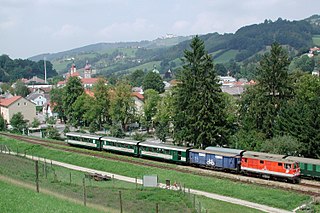
The Ybbs Valley Railway was a narrow-gauge railway of the Austrian Federal Railways with a track gauge of 760 mm, located in the Lower Austrian Mostviertel.
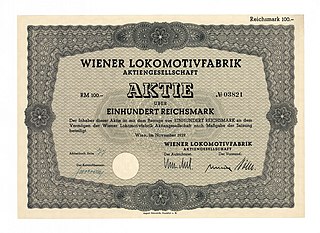
Lokomotivfabrik Floridsdorf was an Austrian locomotive works founded on 6 September 1869 that achieved a pre-eminent place amongst European locomotive builders thanks to the quality and diversity of its designs.

The German narrow gauge steam locomotives of military field railway (Heeresfeldbahn) class HF 160 D were 0-8-0 tender locomotives developed for wartime service during the Second World War. The engines were also classified as Kriegsdampflokomotive 11 or KDL 11. After the war the locomotives were put to use for civilian purposes.
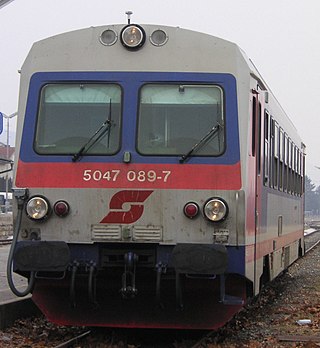
The ÖBB Class 5047 are diesel railcars used in regional transportation. The trains were built by Jenbacher Werke and entered service in 1987. The GySEV and the Steiermarkbahn also have railcars of this type.

The Southern Railway is a railway in Austria that runs from Vienna to Graz and the border with Slovenia at Spielfeld via Semmering and Bruck an der Mur. Along with the Spielfeld-Straß–Trieste railway, it forms part of the Austrian Southern Railway that connected Vienna with Trieste, the main seaport of the Austro-Hungarian Monarchy, via Ljubljana. A main obstacle in its construction was getting over the Semmering Pass over the Northern Limestone Alps. The twin-track, electrified section that runs through the current territory of Austria is owned and operated by Austrian Federal Railways (ÖBB) and is one of the major lines in the country.

The Gutenstein Alps are a mountain range in the Eastern Alps in Central Europe, and the northeasternmost part of the Northern Limestone Alps, reaching heights over 1,000 m.

The Rax-Schneeberg Group is a mountain range in the Northern Limestone Alps on the Styrian-Lower Austrian border in Austria.
NÖVOG is a public transport operator, owned by the provincial government of Lower Austria. It holds concessions for a number of regional and heritage railways.

Trams in Vienna are a vital part of the public transport system in Vienna, capital city of Austria. In operation since 1865, with the completion of a 2 km (1.2 mi) route to industrial estates near Simmering, it reached its maximum extent of 292 km (181.4 mi) in 1942. In February 2015, it was the fifth largest tram network in the world, at about 176.9 kilometres (109.9 mi) in total length and 1,071 stations.

The first railway in Austria was the narrow-gauge line from Gmunden in the Salzkammergut to Budweis, now in the Czech Republic, this was 1,106 mm gauge. Some two dozen lines were built in 760 mm gauge, a few in 1,000 mmmetre gauge gauge. The first was the Steyrtalbahn. Others were built by provincial governments, some lines are still in common carrier use and a number of others are preservation projects. The tramway network in Innsbruck is also metre gauge; in Linz the rather unusual gauge of 900 mm is in use.

Vienna's Hausberge are the mountains of Raxalpe, Schneeberg and Hohe Wand in the south of the state of Lower Austria. These mountains may be reached from Vienna in about an hour and are therefore a popular recreation area for the Viennese.

The BBÖ 478 was a class of fifty 0-8-0T shunting locomotives of the Bundesbahnen Österreich (BBÖ).
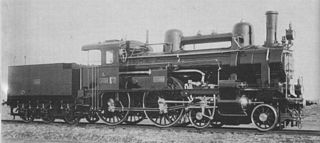
The kkStB 6 was a class of 68 express passenger 4-4-0 locomotives of the Imperial Royal Austrian State Railways.



